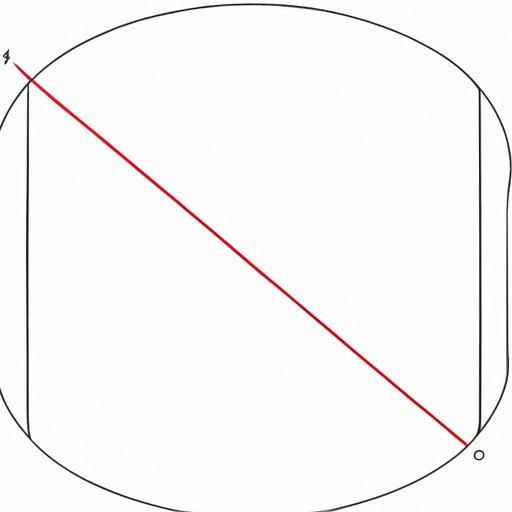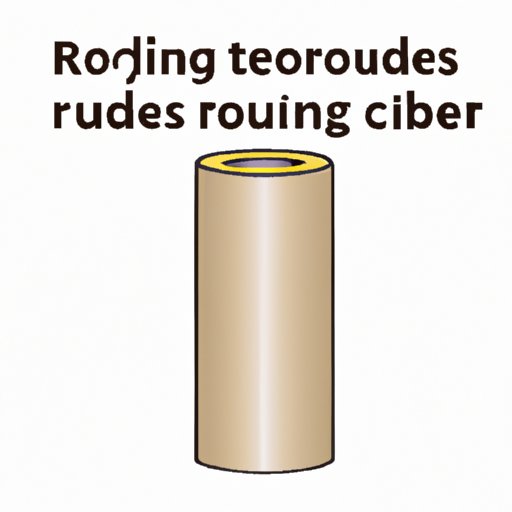
Introduction
If you’ve ever encountered a cylinder in real life or during a math problem, you may have been tasked with finding its radius. Knowing the radius of a cylinder is essential in many fields, including engineering, architecture, and science. Whether you’re a student or a professional, having the skills to find the radius of a cylinder quickly and accurately is an important skill to have.
In this guide, we’ll explore a step-by-step approach to quickly find the radius of a cylinder, the math behind calculating the radius, and alternative methods of solving for the radius. We’ll also discuss common mistakes to avoid and provide tips for increasing accuracy when completing radius calculations.
Quick and Easy Steps to Finding the Radius of a Cylinder
Calculating the radius of a cylinder doesn’t have to be a difficult task. By breaking down the process into simple steps, you can quickly find the radius of any cylinder you encounter.
Step 1: Measure the height of the cylinder. This can be done using a ruler or tape measure. Record the measurement.
Step 2: Measure the diameter of the base of the cylinder. This can be done using a ruler, tape measure, or a pair of calipers. Record the measurement.
Step 3: Divide the diameter by 2 to find the radius. The radius is the distance from the center of the circle to its edge. For example, if the diameter is 10cm, then the radius is 5cm.
Let’s look at a real world example. If you want to find the radius of a can of soda, you would simply measure its height and diameter, then divide the diameter by 2 to find the radius. With these simple steps, you can quickly and accurately find the radius of any cylinder.
Mastering the Math: Calculating the Radius of a Cylinder
The above method is a quick and easy way to find the radius of a cylinder. However, it’s also important to understand the math behind calculating the radius in case you encounter a more complex problem.
The formula to calculate the radius of a cylinder is:
Radius = Diameter / 2
Where:
- Radius is the distance from the center of the cylinder’s base to its edge.
- Diameter is the distance across the cylinder’s base.
If you have the diameter of the cylinder, simply divide it by 2 to find the radius. For example, if the diameter is 14cm, the radius would be 7cm.
If you have the circumference of the cylinder’s base and need to find the radius, the formula is:
Radius = Circumference / (2 * π)
Where:
- Radius is the distance from the center of the cylinder’s base to its edge.
- Circumference is the distance around the base of the cylinder.
- π is a mathematical constant that represents the ratio of the circumference of a circle to its diameter. It is approximately equal to 3.14.
For example, if the circumference of a cylinder is 44cm, the radius would be:
Radius = 44 / (2 * π) = 7cm
Understanding and Solving for the Radius of a Cylinder
Knowing basic geometric concepts and formulas is key to solving for the radius of a cylinder. Here are the steps to solve for the radius using some common formulas:
Volume of a Cylinder:
The volume of a cylinder can be calculated using the formula:
Volume = π * r^2 * h
Where:
- r is the radius of the cylinder
- h is the height of the cylinder
If you have the height and volume of the cylinder, you can solve for the radius using the following steps:
Step 1: Divide the volume of the cylinder by the height to find the area of the base of the cylinder.
Step 2: Divide the area of the base of the cylinder by π to find the radius squared.
Step 3: Take the square root of the radius squared to find the radius.
For example, if a cylinder has a height of 10cm and a volume of 500cm^3, the radius can be found using the following steps:
Step 1: Area of the base = Volume / Height = 500 / 10 = 50cm^2
Step 2: Radius squared = Area of the base / π = 50 / π = 15.9155cm^2
Step 3: Radius = √(?15.9155) = 3.993cm
Surface Area of a Cylinder:
The surface area of a cylinder can be calculated using the formula:
Surface Area = 2πr^2 + 2πrh
If you have the height and surface area of the cylinder, you can solve for the radius using the following steps:
Step 1: Divide the surface area of the cylinder by 2πh to find 2r + h.
Step 2: Subtract the height from 2r + h to find the radius.
For example, if a cylinder has a height of 5cm and a surface area of 100πcm^2, the radius can be found using the following steps:
Step 1: 2r + h = Surface Area / 2πh = 100π / 2π * 5 = 10
Step 2: Radius = (2r + h) – h = 10 – 5 = 5cm
The Ultimate Guide to Finding the Radius of a Cylinder
Now that we’ve explored multiple methods to find the radius of a cylinder, let’s recap some of the key points:
– The easiest method to find the radius is by measuring the height and diameter of the cylinder and dividing the diameter by 2.
– The formula to find the radius of a cylinder is radius = diameter / 2 or radius = circumference / (2 * π).
– To solve for the radius using other formulas, it’s important to know the basic geometric concepts and formulas.
– Common mistakes to avoid when calculating the radius include incorrect units, rounding errors, and forgetting to divide by 2.
If you’re looking to deepen your understanding and improve your radius calculations, there are many additional resources available online and in textbooks.
Simplifying Geometry: Steps to Calculate the Radius of a Cylinder
While we’ve explored several methods to find the radius of a cylinder, there are also alternative methods and formulas that can simplify the process even further.
One such method is using a right-angled isosceles triangle to calculate the radius. Here are the steps:
Step 1: Construct a right-angled isosceles triangle with one leg equal to the height of the cylinder and the other leg equal to half the diameter of the cylinder. The hypotenuse of the triangle will equal the radius of the cylinder.
Step 2: Use the Pythagorean theorem to solve for the hypotenuse (radius) of the triangle.
For example, if a cylinder has a height of 20cm and a diameter of 12cm, the radius can be found using the following steps:
Step 1: Construct a right-angled isosceles triangle with one leg equal to 20cm and the other equal to half of 12cm (6cm). The hypotenuse (radius) will equal the missing side.
Step 2: Use the Pythagorean theorem: a^2 + b^2 = c^2. In this case, a = 20, b = 6, and c = ?, so the equation would be 20^2 + 6^2 = c^2. Solving for c, we get a radius of 20.4cm.
This method may seem more complex at first, but it can be useful in situations where a cylinder has an irregular shape or you are unable to easily measure the diameter.

No More Guessing: Tips for Accurately Finding the Radius of a Cylinder
Now that we’ve explored multiple methods for finding the radius of a cylinder, it’s important to also discuss common mistakes to avoid and tips for increasing accuracy.
1. Be consistent with units: Make sure all measurements are in the same unit (centimeters, meters, etc.) before starting any calculations.
2. Use precise measurements: Inaccuracies in measurements can throw off your final calculation. Use a ruler or calipers to make precise measurements whenever possible.
3. Don’t forget to divide by 2: When using the formula radius = diameter / 2, be sure to divide the diameter by 2 to find the correct radius.
4. Double-check your calculations: It’s always a good idea to double-check your calculations to ensure accuracy. Use a calculator if needed.
Breaking Down the Formula: How to Find the Radius of a Cylinder with Ease
Finally, let’s break down the formula for finding the radius of a cylinder to make it even easier to understand:
Radius = Diameter / 2 or Radius = Circumference / (2 * π)
Simply divide the diameter by 2 or divide the circumference by 2π to quickly find the radius of a cylinder.
It’s important to note that this formula assumes the cylinder has a circular base. If the cylinder has an irregular shape, the formula may not be applicable.
Conclusion
In conclusion, finding the radius of a cylinder is an important skill for anyone who encounters cylinders in their work or daily life. Whether you use a quick and easy method or prefer to dive deeper into the math and geometry, there are multiple approaches to finding the radius that can work for you. Remember to be consistent with units, use precise measurements, and double-check your calculations for increased accuracy.




